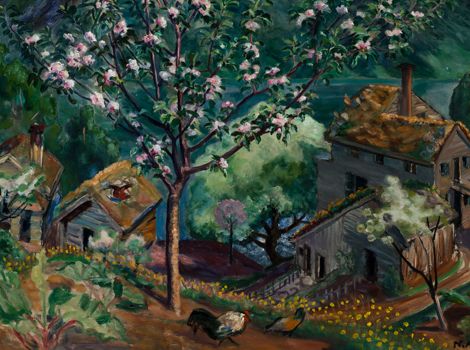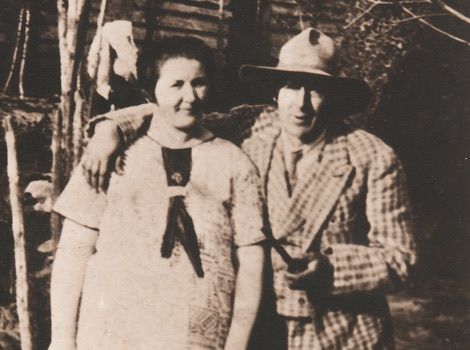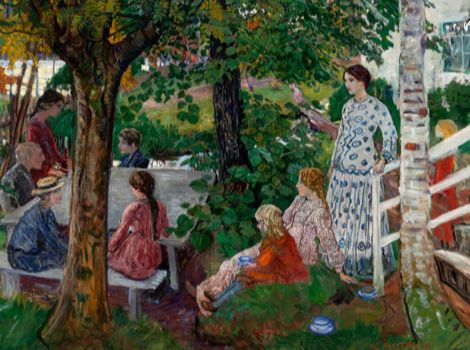Contents and Navigation
Catalogue Raisonné
This annotated catalogue offers an authentic and chronological overview of Nikolai Astrup’s artistic production, including technical specifications and a description of the provenance, exhibition history and bibliography of each individual work.
The digital catalogue contains approximately 230 paintings and a complete collection of the artist’s printing blocks. This is an ongoing research project; in the coming years the catalogue of works will be updated regularly, and supplemented with newly discovered paintings.
OBJECT TYPE
Here you can choose between two different material categories: painting and printing blocks. The category list will be expanded with graphic art, drawing, photography, banners and design.
SUBJECT
The database of artworks can be divided into six different genres: illustrations, interiors, landscapes, portraits, self-portraits and still lifes.
LOCATION
The range of motifs in Astrup’s art is largely limited to the village of Jølster, and can be divided between the locations of Ålhus, Myklebust, Sandalstrand and Sunde.
DATE
Astrup’s artistic career spanned the period from ca. 1890 until his death in 1928. You can limit the overview within this time frame by using the “from – to” search window (at bottom of left column).
Search
You can search in the database by using free text in the search window. The overview can be divided up chronologically, with the oldest or latest work first (arrows, to the right of search window), and via the grid icon or list icon (to the right of the arrows). The “Load more results” function allows you to upload additional search results, while the arrows at lower right will return you to the top of the page.
Artwork Entry
The presentation of artworks includes technical specifications and a description of the provenance, exhibition history and bibliography of each individual work.
The work is introduced with the fundamental data. This includes the title, dating of the work, technique and ID number, as well as genre, keywords and the geographical location of the motif. The fundamental information is accompanied by a short presentation, while questions related to the motif, titles or dating are elaborated on in an analysis (see “critical commentary”).
The presentation also includes a high-resolution image of the work, which can be explored via the zoom function. In some cases the presentation of the work can include additional related pictures. This might be a photograph of the work with its frame, including a photo of the reverse side, historical photos, or technical photos.
ID
An artwork can have several ID numbers, such as the different inventory numbers used by museums, for example. The paintings presented here will contain the catalogue number from Øystein Loges catalogue (1985), and the number from Astrup’s own list of works (1927). Astrup’s graphic works and printing blocks are equipped with the numbers from the Jan Askeland’s catalogue (1956) and Kari Greve’s catalogue (2010).
When the project is completed, the various material groups will be given a unique CR number, which will reflect a chronological sequence in Astrup’s oeuvre.
Title
An artwork often has multiple titles in the historical references. The Catalogue Raisonné distinguishes between the established title, previous titles and incorrect titles, in addition to Astrup’s own titles.
Date
The dating of Astrup’s works is registered with two dates: this indicates the time frame we assume the work was created in. The use of a window of time reflects the challenges associated with the dating, as the artist rarely dated the individual works himself. The time frame “1902–1908”, for instance, reveals that the work was painted after the artist completed his studies in 1902, but before it was exhibited in 1908.
Signature and Inscription
Primary signature/inscription is the artist’s personal signature, while secondary inscriptions were made by others after the artist’s death. The signature and inscription is indicated with upper and lower case letters and punctuation as they appear in the picture.
Subject, Keywords and Location
Genre and keywords are parameters that distinguish Astrup’s work. The words are interactive and open to overviews of works that belong to the various categories. The geographical location of the motif, if this is known, is marked with a coordinate in a digital map. This indicates the spot where Astrup stood when he painted the work.
Technical Description
The technical presentation contains an overview of the type of work, technique and type of support, as well as a detailed list of different measurements. The measurements are stated in millimetres in an effort to provide the most precise information possible. Any issues regarding the condition, material and technique will be elaborated upon in a technical analysis.
Provenance
Provenance reveals the ownership history of the work, with the owner’s name, dates of ownership and shift in owners, as well as the manner in which it was acquired. The provenance always includes the artist first, as he owned the work himself between its completion and transference to a new owner. The direct transference between two owners is indicated with a semicolon, whereas if the transference between two parties is unknown or uncertain, a period is used. A dash before or after a date of transference in ownership indicates that the date is uncertain.
Due to privacy protection regulations and the European Union’s GDPR, owners born after 1920 remain anonymous (“private owner”) unless they desire publicity.
A complete provenance register is an exception rather than the rule, but the goal of the catalogue project nevertheless. The provenance register will be regularly updated, as new information comes to light.
Exhibition History
The presentation of a work includes an overview of solo and group exhibitions in which the work has been shown throughout its history. Supplementary information regarding the individual exhibitions is available under “Resources”: https://nikolai-astrup.no/en/exhibitions
Bibliography
The bibliography contains an overview of the source material that is specific for the work. A complete bibliography of published and unpublished literature on Astrup’s life and work is accessible under “Resources”: https://nikolai-astrup.no/en/bibliography
Citing the Catalogue
Haugsbø, Tove, Nikolai Astrup Online Catalogue Raisonné, Oslo/Bergen: The Savings Bank Foundation DNB and KODE Art Museums and Composer Homes 2020–2022. Link: https://nikolai-astrup.no/en
Individual works are referred to with its established title and unique URL.
Copyright
Many of the pictures are protected by copyright, and cannot be published without the prior consent of the owner.


